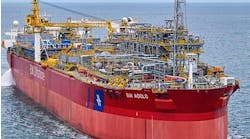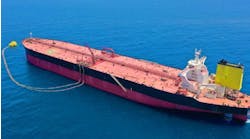Jay Schempf, Special Correspondent
One might say that heavy lift cranes have been around forever and that not many new ideas are to be expected in that industry. Indeed, says Anne De Groot, the basic concepts do not change, but there are changes in the way things are done. One example says De Groot, of Huisman-US in Houston, is development of the mast crane concept, which proves to be especially useful for the offshore petroleum industry.
Developed by parent company Huisman-Itrec of the Netherlands, the mast crane resembles a kingpost crane and shares the advantage of the inherent safety of that crane type. But the mast crane possesses several additional advantages, De Groot said, including certain features that are distinctly different from other crane types.
According to the company, probably the most important of these advantages is the mast crane’s small footprint. Combined with the absence of any tail swing, this means that the mast crane takes up very little deck space, which is always in short supply on offshore structures, floating or fixed. And, added De Groot, the outreach of the mast crane at a certain capacity is often larger that that of other crane configurations. This makes it suitable also for production units, since it allows supply vessels to stay at a greater distance away from the host structure.
The mast crane was developed originally some 25 years ago for the heavy-lift shipping industry. Subsequently, the concept was brought to the offshore industry, where the crane’s small deck space requirements - but also the lower construction weight and low center of gravity - proved to be advantageous.
Increasing capacity
Mast cranes have been built up to 800 tonm capacities, he said. An increasing number of these cranes have showed up on offshore construction and pipe lay barges around the world. Currently, three more cranes of 800-tonm capacities are under construction, De Groot said. These will be operational in the GoM, off West Africa and in the Far East. A 3,000-short-ton version with a 300-ft boom is now under construction. It will be delivered at the end of this year for installation on a construction/pipe lay vessel. Mast cranes of even larger capacity are on the drawing board, he added.
Traction winches for ultra-deep water,
“As the industry moves into ever-deeper water and subsea completions take over from fixed platforms, there is the need for installation equipment for the subsea infrastructure,” said De Groot. “This calls for deep-reach cranes that are fitted with heave compensation.” So far, he added, Huisman has delivered three mast cranes suitable for construction work at 10,000-ft water depths. Three more such cranes are currently under construction.
“These cranes are based on single-line lifting arrangements using large-diameter, low torque wire cable,” said De Groot. He added that traction winches are used instead of regular winches, which is another new development in crane design. A heave compensation system also has been developed that combines passive and active components, which allows for a completely controlled and inherently safe load transfer from crane to well head.
Deepsea deployment from small mono hulls
Against the background of rising day rates for mobile offshore drilling units, there is an increased desire by operators to install subsea infrastructure using small mono-hull vessels, he observed.
The first such vessel to be specifically outfitted for this task, he said, currently is under construction for a new-build vessel for Otto Candies. This vessel will be operated by DMT. Both Otto Candies and DMT are U.S. companies There, a hoisting system for deepwater deployment is combined with a deck handling system in such a way that the load is kept under complete control at all times, both above and below water. The system also can be used for safe retrieval of christmas trees or subsea well intervention equipment.
“In effect, lifting is no longer done with a crane, but rather with a mast and cursor system,” said De Groot. “The objects to be placed on the seabed are lowered through a moon pool at the location, where vessel motions are the smallest.”
Other ideas, reliability
Huisman has introduced several other less visible, but no less useful ideas that increase the versatility and reliability of offshore cranes, De Groot said.
Small, trolley-mounted hoists run along the boom of a large mast crane, he noted. “In so doing, a large and therefore slower crane is turned into a fast gantry for moving smaller loads across the deck or for loading supplies.”
Also, he said, a system can be installed that allows changing the string-up of the hoist block by remote control from the crane operator’s cabin. With this feature, hoisting capacity and speed can be optimized for the actual load within minutes. This design improvement is especially advantageous for application in drilling derricks and has demonstrated its usefulness with proven performance on Helix’s custom-designed Q4000 dynamically positioned, semi-submersible construction vessel.
With the advent of mast-type designs, overall crane downtime becomes ever shorter as a result of design simplifications and increasingly more built-in redundancy, said De Groot. Rigorous shop testing of the drive systems prior to delivery ensures short commissioning times after delivery and reliable operation thereafter.
Finally, the lift capacity of the first mast cranes - some of which were built a quarter-century ago - are now being upgraded from 550 tons to 700 tons.
For more information on mast cranes and other heavy lift products, contact Anne De Groot at 281-586-7676; cell: 281-627-8668; E-mail:[email protected]. Web site: www.huisman-itrec.com.




